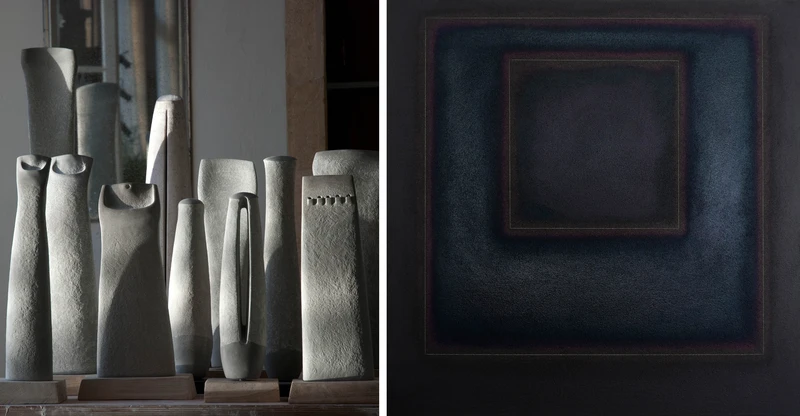Yves Dana & Richard Höglund
28 Jun-23 Sep 2023
PV 27 Jun 2023, 6-8pm


This summer, Waddington Custot presents works by Egyptian-born Swiss sculptor Yves Dana and American painter Richard Höglund, two artists complementary to one another for the powerful simplicity of their works which are rich with historical reference.
Yves Dana
Yves Dana’s (b.1959, Alexandria, Egypt) sculptures are inspired by ancient Egyptian and Cycladic forms. At the heart of the exhibition, two monolithic sculptures, each over three metres in height, reveal how the artist works on a monumental scale in stone and bronze. These will be accompanied by a further number of freestanding sculptures shown together in a group, and table top pieces which more directly relate to the proportions of the human body.
Dana was born in Egypt but his family were forced to flee Alexandria in 1961 during an expulsion of Jewish people and other minorities from the country. He grew up in Switzerland but returned to Egypt on a six-month trip in 1996 that proved transformational to his practice. Dana started experimenting with limestones and basalts, inspired by the ancient and current history of the country. It was here that the elegant forms of Dana’s upright sculptures found their origins, inspired by the Egyptian felucca – simple, traditional sailboats used in pharaonic times and still in operation today.
For Dana, sculpture-making is purely instinctive; he works directly with the materials without preparatory sketches or maquettes. He sources stone from around the world – limestone from Egypt, France and Turkey, serpentine from Italy, diabase from Germany – and combines innovative carving techniques with traditional tools to create precise planar forms.
There is a deliberate sense of timelessness in Dana’s work; he intentionally erodes the otherwise sleek surface of his sculptures as he describes: ‘I feel more like an archaeologist, looking for meaning in a form once the layers are stripped away. I want these sculptures to feel as if they have emerged from the sands after thousands of years of burial.’
Richard Höglund
Richard Höglund (b.1982, Sumter, South Carolina) investigates what it means to paint, exploring the significance of traditional media, such as drawing and painting, and their fundamental artistic method. The works selected for the exhibition are from his Four Quartets series, which are dense with historical references: from geometric principles of ancient Egypt to those of Swiss-French architect Le Corbusier; from Rembrandt to Reinhardt, who were celebrated for creating luminosity out of darkness within their paintings.
The most direct reference made by these works is to the iconic Homage to the Square series by German-born artist and educator Josef Albers, from which the paintings take their compositional structure. Combinations of three or four concentric squares are outlined in goldpoint, creating a framework into which dark pigments are pressed into a prepared ground. As the viewer moves around the work, each individual square emerges, defining itself from the others by the way light is absorbed or reflected within the surface.
The ground of the painting is built up using indigo, basalt, marble and bone: materials selected for their optical properties and each imbued with symbolic meaning for the artist, as he explains: “I think of indigo as the deep, whether the cosmos or the sea. I think of bone dust as the eventuality of the body, and marble dust as the eventuality of what we make. Basalt is my rock of the North and is reminiscent of voyages I would undertake in a mad hunt for a lost Burkean sublime.”
In some instances, indigo is combined with dioxazine, copper or iron to create an iridescent effect, causing the squares to glow outwards, hovering ahead of the painting surface. Albers explored the interaction of colour in his paintings, which raised questions about perception that Höglund pursues in a study of light itself: “These paintings come alive in low, natural light as it changes by the hour and the season. They are perhaps at their best at dawn, or at twilight, when the eye needs time to adjust. A painting is not an image. A painting requires your presence, light and time; time for looking and for apparitions to come and go with your thoughts.”